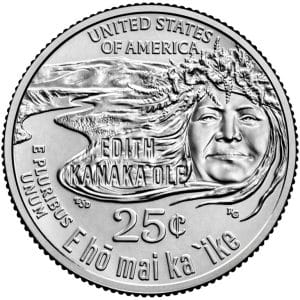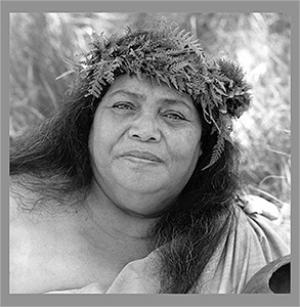The Islanders simply called her Auntie Edith, they considered her a national living treasure. Edith Kanaka’ole believed strongly in traditional Hawaiian culture and spent her lifetime preserving and passing it on. There were times of discrimination in the late 1800s and early 1900s when it was all slipping away. Some colonists did not want the Hawaiian ways, they didn’t want the Hawaiian language or the hula taught. They cared little for the lifestyle of old Hawaii and cared even less for taking care of the land. But, because of people like Edith Kanaka’ole, many ancient Hawaiian ways are now preserved for future generations.
Edith Kanaka’ole’s full Hawaiian name is Edith Ke’kuhikuhiipu’uoneonaali’iokohala Kenao. Since some people can find this hard to pronounce, you’ll see a shorter version of her name on the reverse (tails) side of our quarters. You’ll also see the words “E ho mai ka ike,” which is one of her favorite chants, which means “granting wisdom.” The Edith Kanaka’ole quarter was issued on March 27th and is the seventh installment in the American Women Quarter Series.
Young Edith was born in Honomu, Hawaii, on October 30, 1913, in a very small village near Hilo. When she was 6, her family moved a few miles south to Keaukaha and were among some of the first homesteaders there. Keaukaha means “passing current,” and today is a populous recreational area with a long stretch of beautiful beaches.
As a child, Edith spent days at the beach or river catching fish with her family. She learned the importance of living off the land and never taking more than you needed. She was taught the hula at a young age. Later Edith would start a dance school in her mother’s honor. Kanaka’ole’s style of hula dancing is easily recognizable. It is performed from a low bent-knee stance.
Edith dropped out of formal education and didn’t finish middle school. She always mentioned that she made it to seven and a half. Much of her later education was self-taught and came out of passion and concern for Hawaiian culture. By age 33, she began to compose traditional Hawaiian music and choreographed hula movements to accompany many of her chants.
In 1953, at age 40, Edith founded a dancing company named Hālau O Kekuhi. She wanted to promote hula as a classical dance, not just folk art. Hula is not an easy dance to learn. It takes physical stamina, skill, and hours of practice, much like modern dance, ballet, and the like. In the 1950s, she traveled the continental United States, Canada, and much of Asia performing the hula.
Edith could also speak fluent Hawaiian and was passionate about preserving the language. She didn’t want to see any Hawaiian tradition disappear. Edith created courses in Polynesian history, genealogy, and Hawaiian chant and mythology. She taught at both community colleges and universities, becoming a cherished educator over the years.
Her teaching went way beyond the classroom. She often performed on stage, made musical albums, held workshops, or led symposiums. Edith shared her knowledge of Hawaiian traditions and didn’t want any to be lost. She was proud of being a direct descendant of a long line of performers of Hawaiian chants and dances. Her first album included a collection of chants handed down from her ancestors. She started a family of her own, got married, and raised two sons and four daughters. Edith was later blessed with 17 grandchildren and six great-grandchildren.
Edith Kanaka’ole was named the “Hawaiian of the Year” for 1977 by the State Association of Hawaiian Civic Clubs. It meant a lot to her to be honored by her own people. In December of 1978, she was recognized with a huge festival called Ho’olaule’a. The word means celebration in Hawaiian. It’s an all-day event with dancing, music, food, vendors, and games, much like our carnival or fair. The hula dancing and testimonials rolled on hour by hour during her celebration as Edith Kanaka’ole sat surrounded by flowers and family members. 2,500 Islanders made this a very special day for her.
In February 1979, she received the Governor’s Award. In June of that same year, she received the “Distinguished Service Award” from Brigham Young University – Hawaii Campus on Oahu. Her first album of chants and dances won the 1979 Hoku Award for best traditional album. The Hoku is Hawaii’s premier music award, similar in significance to a Grammy award.
Sadly, her life of selfless giving was cut short by cancer. Edith Kanaka’ole died on October 3, 1979, just weeks before her 66th birthday. She was still teaching college classes at the time and finishing another album, her second one, of Hawaiian chants and dances. Kanaka’ole would later receive a posthumous Hoku Award for best traditional album of 1980.
The hula dances are preserved and passed on. Two of Edith’s daughters run Hālau O Kekuhi, the classical dance company. Traditions are kept, and wisdom is passed on. Edith Kanaka’ole would be proud. Islanders pause each year as October comes around. It’s both the month of her birth and of her passing. They stop and give thanks and remember Auntie Edith.


